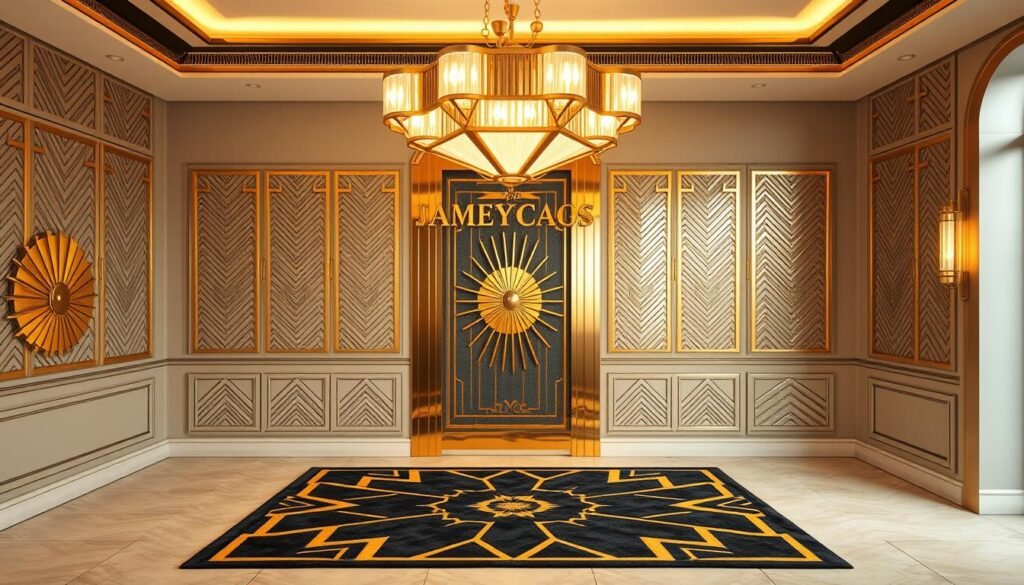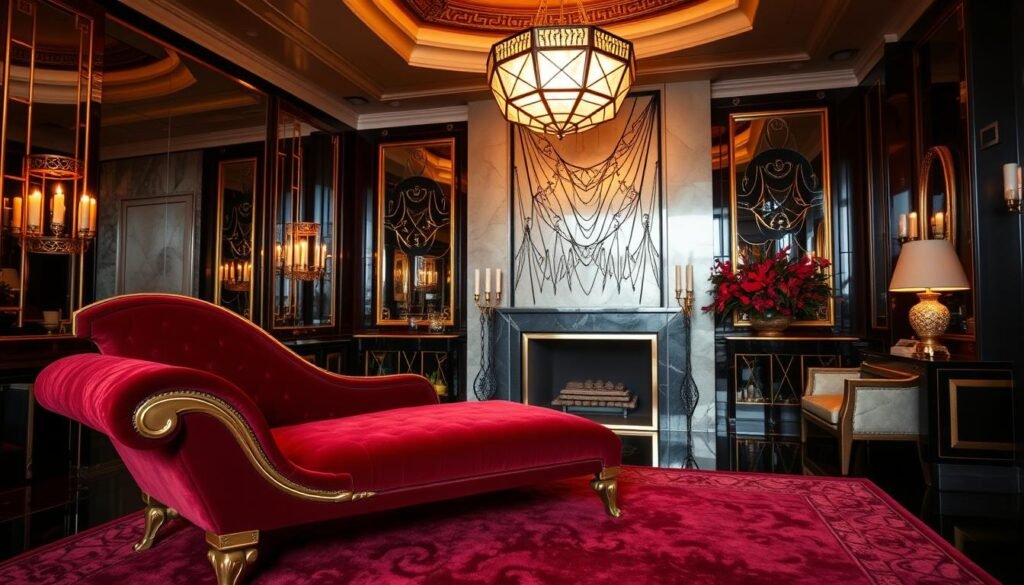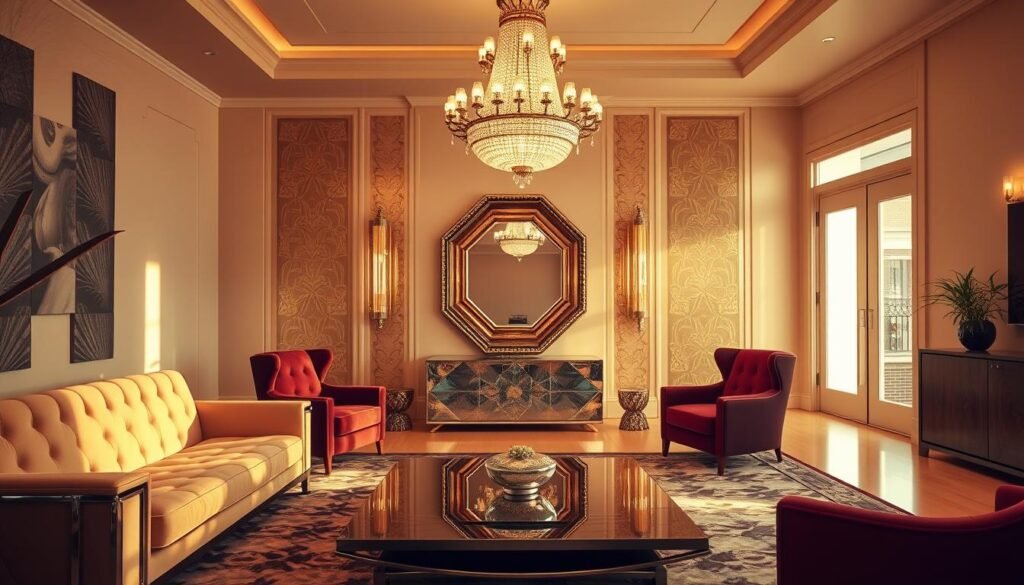Table of Contents
Imagine walking into a space where sharp geometry dances with velvet textures, where every corner whispers “timeless drama” without shouting “dated relic.” Why does this century-old aesthetic suddenly feel fresher than ever? The answer lies in its fearless blend of opulence and restraint – a recipe modern homeowners crave.
Born from Parisian innovation in 1925, this movement redefined luxury through sleek symmetry and industrial-age optimism. Think sunburst mirrors that catch today’s sunlight, zigzag patterns that play nice with smart home tech, and lacquered surfaces that wink at your smartphone’s glossy finish. It’s not about recreating Gatsby’s mansion – it’s about borrowing his confidence.
Exploring the History and Legacy of Art Deco
What happens when ancient civilizations collide with machine-age innovation? The answer shaped one of history’s most striking visual revolutions. Let’s unpack how a post-war Parisian exhibition sparked a global phenomenon still influencing spaces today.
Origins and Early Influences
In the early 20th century, creators rebelled against nature-inspired styles. They blended Cubism’s angles with Bauhaus functionality. Global treasures like Egyptian tomb art and Aztec pyramids added exotic flair. This fusion birthed a style celebrating human progress through bold symmetry.
Technological Innovations and Cultural Shifts
The 1920s brought skyscrapers and shiny new metals. Architects used stainless steel and aluminum to craft sleek surfaces. These materials symbolized hope during tough times. We see this optimism in stepped forms mimicking construction sites and sunburst motifs echoing radio waves.
| Feature | 1920s Innovation | Modern Equivalent |
|---|---|---|
| Materials | Bakelite, Chrome | Recycled Metals |
| Patterns | Ziggurat Steps | Hexagon Tiles |
| Lighting | Frosted Glass | LED Edges |
This movement wasn’t just about looks. It reflected society’s leap into modernity – faster trains, taller buildings, brighter futures. Jazz Age energy lives on in chevron floors and geometric textiles that still feel fresh.
Key Characteristics of Art Deco Interior Design
Step into a room where angular elegance meets tactile indulgence – that’s the magic of this 1920s-born style. Two elements dominate: mathematical precision in shapes and materials that beg to be touched. Let’s unpack what makes these features work so well today.

Geometric Patterns and Symmetry
Your eyes dance across surfaces adorned with sharp chevrons and zippy zigzags. These aren’t random decorations – they’re carefully calculated designs creating rhythm. Picture bathroom tiles forming sunbursts or a rug with overlapping triangles that guide your gaze.
Symmetry acts as the secret sauce. Matching sconces flanking a fireplace, identical armchairs facing each other – these balanced arrangements soothe modern minds craving order. Yet it’s never rigid; staggered shelves or asymmetrical light fixtures can break the mold while keeping harmony.
Luxurious Materials and Rich Colors
Fingertips glide across cool marble countertops before sinking into velvet cushions. Chrome table legs catch sunlight while mirrored surfaces multiply candlelight’s glow. This tactile contrast defines luxury that’s meant to be lived in, not just admired.
Jewel tones create instant drama. Try pairing midnight blue walls with brass accents, or emerald curtains against silver-gray furniture. Modern twists? Swap ruby red for terracotta, or team gold leaf with matte black finishes. The contrast between opulence and simplicity keeps spaces feeling fresh.
What’s brilliant about these elements? They scale beautifully. A single geometric throw pillow or a smoked glass lamp can whisper the style’s essence without shouting “theme party”. That’s timeless design – bold enough to impress, flexible enough to adapt.
Art Deco Interior Design
What if your home could channel Jazz Age sophistication without feeling like a history museum? The trick lies in strategic curation – blending iconic motifs with today’s clean lines. Let’s explore how to walk this tightrope between retro flair and modern practicality.

Incorporating Vintage Style Elements
Start with one showstopper piece. A sunburst mirror above your sofa or geometric pendant lights over the dining table anchors the look. Fluted wood cabinets or ribbed glass vases add texture without overwhelming.
| Vintage Feature | Modern Adaptation | Where to Use |
|---|---|---|
| Fluted wood columns | Textured glass dividers | Room partitions |
| Bakelite handles | Recycled plastic accents | Kitchen cabinets |
| Stained glass | Frosted LED panels | Bedroom lighting |
Balancing Old-World Glamour with Modern Touches
Pair that heirloom lacquered cabinet with a sleek sectional sofa. Use metallic finishes as punctuation marks – brass drawer pulls here, chrome lamp bases there. Pro tip: Update classic black-and-gold schemes with matte navy walls and brushed brass hardware.
Swap traditional ebony finishes for lighter walnut tones. Choose geometric-patterned area rugs with stain-resistant fibers. The goal? Spaces that feel curated, not costumed – where your smartphone charger looks right at home next to a Deco-inspired clock.
Materials, Textures, and Colors in Deco Interior Design
Ever touched a surface that tells a story through its texture? That’s the power of this style’s material mastery. The secret lies in combining industrial sleekness with nature’s raw beauty – creating spaces that feel both futuristic and timelessly grounded.

Exotic Woods, Polished Metals, and Mirrored Surfaces
Run your hand across zebrawood’s wild grain or feel the chill of marble under a cocktail glass. These elements create instant drama. Chrome table legs catch sunlight like disco balls, while mirrored walls turn cramped spaces into endless galleries.
Modern updates? Try recycled glass tiles instead of rare skins. Use brushed brass instead of chrome for warmer tones. The magic happens when you pair matte walnut with high-gloss lacquer – opposites that attract.
| Classic Material | Modern Swap | Best Use |
|---|---|---|
| Sharkskin | Ethical Faux Leather | Accent Chairs |
| Ebony | Stained Ash | Flooring |
| Silver Leaf | Brushed Nickel | Light Fixtures |
Bold Jewel Tones and Metallic Accents
Paint your walls the color of crushed emeralds or midnight sapphires. These rich hues make white ceilings pop like clouds. Metallic touches? Think bronze curtain rods framing windows or copper bookends holding your favorite novels.
Prefer subtlety? Cream walls with gunmetal gray trim work wonders. Add sparkle through smoked glass lamps or silver-threaded pillows. Remember – one bold color + two neutrals + metallic shine = balanced glamour.
Lighting transforms everything. A single amber-tinted pendant can make white walls glow like honey. It’s not about matching metals – it’s about letting each piece sing in harmony.
Art Deco Furniture & Decorative Elements
Ever wondered how furniture can double as art? The answer lies in bold silhouettes that transform practical items into conversation starters. These creations don’t just fill space—they define it through striking proportions and material contrasts.

Sculptural Furniture Pieces and Statement Lighting
Picture a dining table with marble cascading over brass legs like frozen lava. This isn’t just furniture—it’s functional sculpture. Look for armoires with fluted wood details or chairs sporting geometric cutouts that cast shadow patterns at sunset.
| Classic Element | Modern Twist | Room Impact |
|---|---|---|
| Zebrawood veneer | Recycled composite | Adds organic texture |
| Chrome bases | Brushed brass | Warms cool tones |
| Etched glass | LED-backlit panels | Modernizes vintage |
Lighting becomes jewelry for your rooms. A floor lamp with orange glass globes creates sunset hues on walls. Pendant fixtures with stepped metalwork throw geometric shadows that dance during dinner parties.
Iconic Mirrors and Unique Accessories
Sunburst mirrors aren’t just decorative—they’re light multipliers. Place one opposite windows to brighten dark corners. Try hexagonal designs above consoles for instant gallery-wall energy.
Accessorize with purpose: a terrazzo vase holds fresh blooms while echoing 1920s flooring patterns. Metallic bookends keep novels tidy while catching afternoon light. Every piece should whisper elegance without shouting for attention.